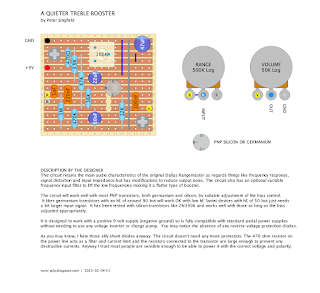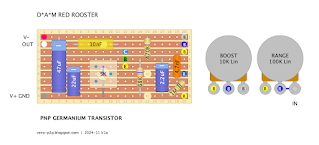Here’s a simple Rangemaster treble booster. I’m jotting down some notes from my recent builds because I really dig this layout. I used a 1590BBS enclosure and an 8-way tag strip. It’s pretty similar to the Pigdog Eel Pie layout, which inspired my design.
Inside, you’ll find a Mullard OC71 transistor. But honestly, the specific transistor isn’t a huge deal—pretty much any PNP germanium transistor will sound great in a Rangemaster. You definitely don’t need an OC44 to get that sweet sound.
What really makes this pedal shine is a couple of key factors:
- Hitting Your Valve Amp Hard: The Rangemaster works best when you crank it into the front of a valve amp.
- Adding Harmonic Distortion: That germanium transistor adds some nice harmonic distortion, which enriches the overall tone.
For the best results, pair it with a valve amp that’s just on the edge of breakup or slightly dirty - there's always a bit of a balancing act between the amp and the boost level. Once you find your happy place, set and forget. Keep in mind that once the amp is clipping, it doesn't really get louder, it gets more saturated, and some bass is trimmed off the signal - for many people, this is the sound that they're looking for.
If you run it into a super clean amp—especially a solid-state one with lots of headroom—you won’t get great results, as it just sounds thin.




















